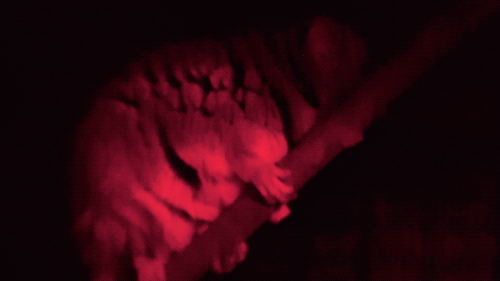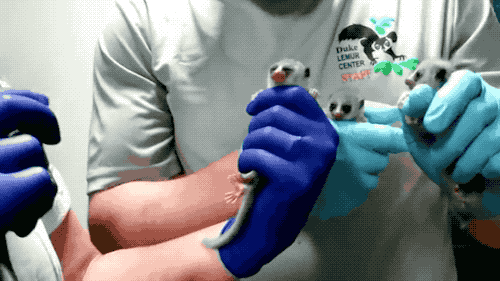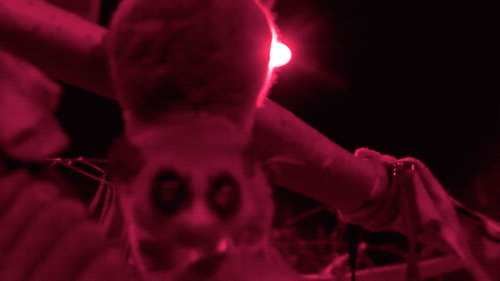Lemurs: They’re Just Like Us (Sort Of)
5:22 minutes
What has big eyes, a bushy tail, and is the only primate to go into hibernation six months out of the year? It’s the fat-tailed dwarf lemur, an endangered species endemic to the island of Madagascar. During their hibernation period, the lemurs enter a state of torpor, which essentially disables the animals’ internal thermostat. It turns out we humans possess the same gene that is activated when the lemur initiates torpor—we just don’t know how to activate it. Science Friday video producer Luke Groskin traveled to the only captive colony of dwarf lemurs in the world outside of Madagascar, the Duke Lemur Center in North Carolina, to investigate the sleeping cuties’ hibernation habits—and how they could apply to humans. Learn more in our latest Macroscope video.



Luke Groskin is Science Friday’s video producer. He’s on a mission to make you love spiders and other odd creatures.
[MUSIC PLAYING] IRA FLATOW: What has big eyes, a bushy tail, and is the only primate to go into hibernation six months out of the year? It’s the dwarf lemur. You knew that, right? [LAUGHS] Our video producer, Luke Groskin, went down to the Duke Lemur Center in North Carolina to investigate the lemur’s strange sleeping habits for our latest macroscope video up now at ScienceFriday.com/lemurs. Hi, Luke.
LUKE GROSKIN: Hi, Ira.
IRA FLATOW: And I want to remind everybody that this is Science Friday from WNYC Studios. So tell us what is a lemur, first of all, because we don’t know what it is.
LUKE GROSKIN: Sure. So lemurs are primates that live on the island of Madagascar. You could only find them on the island of Madagascar. And you’ve probably seen them a lot in pop culture. You’ve probably seen them in the movie Madagascar. Most people associate them with the ringtail lemur, the ones with the little striped tails. They’ve got big eyes. And they are primates, again.
But the lemurs that I went to film at the Duke Lemur Center in North Carolina are fat-tailed dwarf lemurs. So they are about the size of a squirrel. They’re gray and they have giant eyes. They’re nocturnal. So you can only see them in these red rooms. And they have this big fat tail that they use in order to survive hibernation.
IRA FLATOW: So why do people want– are so interested in– why are they so interested in studying lemurs there?
LUKE GROSKIN: Well, in the case of the fat-tailed dwarf lemur, this animal is the only primate that goes into hibernation. So for six months out of the year, this animal basically becomes reptilian. It becomes cold-blooded. Its thermostat shuts down. And its brain activity shuts off completely– almost completely. And it becomes pretty much dormant.
And then every so often– every two weeks– or one week, two weeks depending on the temperature– its thermostat sparks up for a couple of hours. It goes into a sleeping state. Again, hibernation is not sleep. Sleep is an active brain state. Hibernation is a not active state. So it starts to sleep and then it goes back into hibernation again.
IRA FLATOW: It’s amazing, because you can see there’s video on our website at ScienceFriday.com/lemurs. And these are primates. We–
LUKE GROSKIN: We are primates.
IRA FLATOW: So I’m getting–
LUKE GROSKIN: That’s right.
IRA FLATOW: –see a connection here.
LUKE GROSKIN: Yeah, that’s where a lot of the interest comes in. We actually possess some of the genes that the dwarf lemur has that enables it to go into hibernation. Now, we don’t know the mechanisms– the biological mechanisms– that enable the animal to do that. But we know that we share the genes. So there’s a lot of interest. And perhaps we could trigger hibernation in ourselves.
IRA FLATOW: Well, if we trigger, we must study how to stop it.
LUKE GROSKIN: Yes.
[LAUGHTER]
I mean, ideally, once you know how to turn it on, you, hopefully, would be able to turn it off.
IRA FLATOW: I don’t know. That’s an assumption.
LUKE GROSKIN: It’s a whole other round of studies.
IRA FLATOW: So what would you do with– say, you could put somebody into– torpor– well, how do you– torpor? Is that what–
LUKE GROSKIN: Torpor is another way of saying hibernation. Sure. So there’s a lot of things that you could probably do with it. If you’re going in for heart surgery, your surgeon wants to lower your circulation as much as possible.
And so the easiest way to do that is to lower your blood pressure, lower your body temperature, and that makes surgery a lot more safe for them. There are diseases where going into a coma with a much lower body temperature would be really beneficial. The disease would work its way through your system. And then you could wake up and ideally it would be out of your system.
And then, of course, NASA is really interested in this, because they could reduce the payload on the rockets. If you don’t have to bring tons and tons of food for the rockets to eat on their way out to Saturn, or Mars, or wherever they’re going, then you could save a lot of pay– stuff in your rocket.
[LAUGHTER]
IRA FLATOW: That’s a payload.
LUKE GROSKIN: Yeah, payload. That’s the word I was looking for.
IRA FLATOW: But also, one of the biggest problems of traveling in space is radiation.
LUKE GROSKIN: Sure.
IRA FLATOW: So if you were in a sleep state, you could just be put in a cocoon of lead or something, and maybe survive all that radiation.
LUKE GROSKIN: Ideally. I mean, they haven’t sent any dwarf lemurs into space. They are endangered, so they’re not going to.
IRA FLATOW: And that’s the problem. You say in the video one of the problems is it’s an endangered species, so you can’t poke at it or experiment with it.
LUKE GROSKIN: Exactly. The Duke Lemur Center has this captive breeding population. And they do that because a lot of the areas where these animals are living are being deforested. So they had this captive breeding population and you can’t really poke, or prod, or dissect these animals, so they have to be very careful about their studies.
IRA FLATOW: But one of the interesting parts– and this is a great video– as I say, it’s up on our website. It’s ScienceFriday.com/lemurs. Is that when they wake up, it’s like they’ve been awake all that time.
LUKE GROSKIN: I know.
IRA FLATOW: Right?
LUKE GROSKIN: I know. I mean, so if–
IRA FLATOW: They’re not crawling out of bed tired.
LUKE GROSKIN: So people that are in comas, when they wake up, their muscles have been so degraded that they have to regain muscle function. And that takes a long time. These dwarf lemurs don’t have any of those problems. Their kidneys function completely. And scientists don’t understand how they do it. So there’s a lot to be learned from these cute adorable creatures.
IRA FLATOW: And you can see those cute adorable creatures up on our website at ScienceFriday.com/lemurs. Luke Groskin, thank you.
LUKE GROSKIN: Thank you for having me.
IRA FLATOW: Thank you for having another great video.
Copyright © 2019 Science Friday Initiative. All rights reserved. Science Friday transcripts are produced on a tight deadline by 3Play Media. Fidelity to the original aired/published audio or video file might vary, and text might be updated or amended in the future. For the authoritative record of Science Friday’s programming, please visit the original aired/published recording. For terms of use and more information, visit our policies pages at http://www.sciencefriday.com/about/policies/
Katie Feather is a former SciFri producer and the proud mother of two cats, Charleigh and Sadie.
Ira Flatow is the founder and host of Science Friday. His green thumb has revived many an office plant at death’s door.